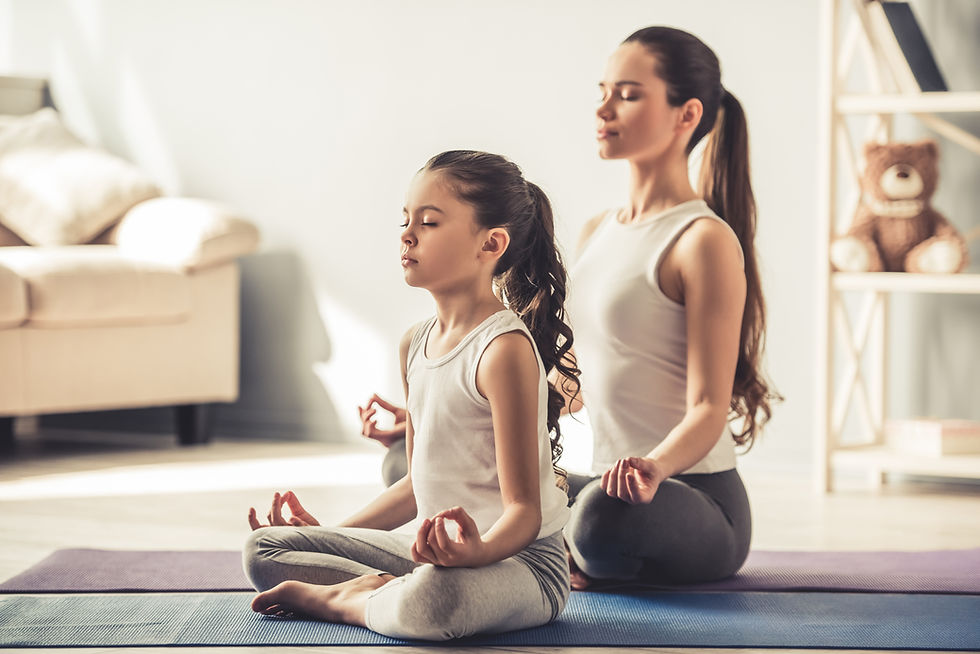How trauma-informed yoga is changing children's lives
- Big Human Jenna

- Jan 7, 2024
- 3 min read
By Sarah Mote, yoga instructor for little humans

We all struggle to heal from traumatic events in our lives, but these experiences can affect little humans differently than big humans. That’s why it’s important for parents and caregivers to know the signs of trauma and to also consider yoga as another path towards their child’s healing.
What exactly is trauma-informed yoga and how can it help?
Trauma-informed yoga goes beyond traditional yoga by prioritizing personal choice and body awareness, while incorporating mindfulness and playful movement. Children get to choose yoga poses which helps them feel in control of their body, while also practicing mindful breathing leading to a more regulated nervous system.
The benefits for little humans
Manage difficult emotions | Develop body awareness | Increase self-esteem | Build long-term resilience |
Through breathing exercises and gentle poses, kids can learn to calm their nervous systems and cope with anxiety, anger, or sadness in a healthy way. | Trauma can disconnect us from our bodies. Yoga helps children reconnect with their physical sensations, fostering a sense of embodiment and trust in their own internal cues. | Yoga encourages exploration and acceptance of different body shapes and abilities, building self-confidence and empowering children to feel comfortable in their own skin. | By practicing yoga, children can develop coping mechanisms and internal resources to navigate challenges and bounce back from difficult experiences. |
Yoga is catching on

While this may seem like a new idea to some, it’s important to remember that many scientific studies have demonstrated the benefits of children’s yoga, and it’s becoming a popular feature in school curriculum across the United States. In fact, more than 900 schools have begun to offer yoga, and preliminary research findings “suggest that providing yoga within the school curriculum may be an effective and feasible way to help youth develop skills in stress management and emotional regulation” (Butzer, 2015).
A few tips on teaching yoga to little humans

Photo by Kamaji Ogino: https://www.pexels.com/photo/ethnic-mother-and-cute-kid-practicing-yoga-together-at-home-5093584/
You may think teaching yoga to kids is easy, but it takes some practice… just like learning to practice yoga as an adult! In my own kids’ yoga classes, I try to prioritize a combination of mindfulness and movement to help children manage difficult emotions, develop body awareness, increase self-esteem, and build long-term resilience (just like Milo!).
Where to learn more
If you're curious and want to learn more, you can begin to explore trauma-informed yoga through Yoga Ed's courses, toolkits, and resources about trauma-informed yoga for kids and parents alike. Or, if you prefer a screen-free option, you can try Jennifer Cohen Harper‘s Yoga and Mindfulness Practices for Children Card Deck that offers over 50 activities to support health, well-being, and empowerment. You can also email me for more info.
If you’re more inclined to practice yoga in-person or with a community, look for qualified yoga instructors in your area who are trained in trauma-informed practices. You can even practice yoga alongside your child to connect and create a shared experience of well-being. Start slowly and gradually build a yoga practice that feels empowering and comfortable.
Whether you’re looking for a local yoga practice or planning to try it out at home with help from Yoga Ed’s YouTube, it’s important to remember that trauma-informed yoga should:
● Prioritize choice and autonomy: children should have the freedom to choose whether or not to participate in any activity and to modify poses as needed.
● Focus on internal experience: rather than emphasizing perfection in poses, the focus should be on how each child feels in their body.
● Engage in playfulness and mindfulness: activities and poses should be fun and creative, avoiding anything that might feel pressured or intimidating.
● Create a safe and predictable environment: effective kids’ yoga classes create a calm and predictable space where children feel safe and respected as individuals with agency.
● Remain culturally responsive: trauma-informed yoga classes should be mindful of all cultural backgrounds and adapt practices accordingly. Sometimes this requires an ongoing dialogue between participants and the instructor.
Above all, a kids’ trauma-informed yoga class should be a gentle path to healing, empowerment, and self-discovery.




Comments